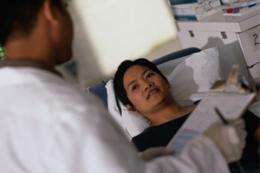Doctors in U.S. overuse pap smears

A new study finds U.S. physicians are performing Pap smears far more often than needed to prevent cervical cancer. The study, published in The Milbank Quarterly, examines Pap smear usage alongside cervical cancer mortality data in the U.S. and the Netherlands between 1970 and 2007. While American doctors performed about three or four times as many Pap smears as Dutch doctors did, the rates at which women developed or died from cervical cancer were roughly equal for the two nations.
“This strongly suggests that the Dutch approach to cervical cancer screening is much more efficient than the U.S. approach. We did detect some potential shortcomings in the Dutch approach, but the evidence suggests that the U.S. could move substantially in the direction of the Dutch program, at considerable economic savings, without sacrificing health benefits,” said co-author Martin L. Brown, Ph.D., of the National Cancer Institute.
The Netherlands has long treated cancer screening as a national public health endeavor carried out by doctors who generally follow National Ministry of Health guidelines, the study reports. Meanwhile, the U.S. follows a medical model: individual doctors choose who to screen and how often. U.S. doctors select from or ignore guidelines from various organizations and from the government’s U.S. Public Health Service.
Overall, in the Netherlands, cancer screenings adhere to the most recent evidence. There, a woman generally undergoes a lifetime total of 7 Pap smears between ages 30 and 60. Doctors typically screen patients every five years, depending on their age and risk level.
“In the U.S., actual medical practice lags behind and diverges strongly from evidence-based guidelines,” says Brown. Screening guidelines U.S. doctors adopt from highly influential medical societies vary widely, calling for anywhere from 20 to 33 Pap smears. Screenings often take place annually, without regard for a woman’s age or risk.
While the study discussed only cervical cancer evidence, the authors did note that its themes might apply to differences in screening for many preventable diseases.
Darcy Phelan, DrPH with the Johns Hopkins Bloomberg School of Public Health, hopes that policy makers will consider these findings as they address ways of preventing cervical cancer that are more efficient. “These findings suggest that broad adoption of a policy to extend the Pap screening interval will protect patient safety while reducing costs. This will be especially important as prevention costs escalate in the context of human papillomavirus (HPV) vaccination among girls and young women.” Both experts noted that the U.S. Preventive Services Task Force included extension of the interval in its recently updated cervical cancer screening guidelines.
Phelan added that the study confirms the importance of screening all women, as most cervical cancers occur among those never screened or not screened within the recommended interval. Screening all women has great potential to reduce persistent racial and ethnic disparities in cervical cancer in the U.S., she says.
More information: Habbema, D., et al (2012). Cervical Cancer Screening in the United States and the Netherlands: A Tale of Two Countries. The Milbank Quarterly, 90: 5-37. onlinelibrary.wiley.com/doi/10 … 09.2011.00652.x/full














